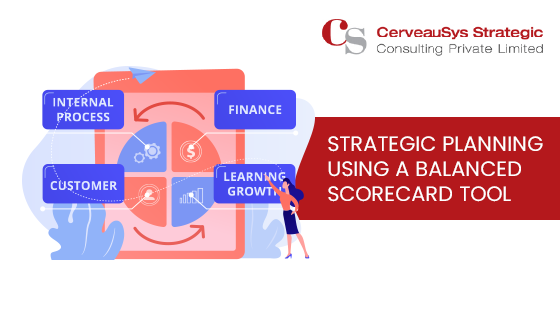STRATEGIC PLANNING USING A BALANCED SCORECARD TOOL

Strategic planning is crucial for businesses seeking to thrive and boost performance. It guides a company’s overall direction by establishing long-term objectives, identifying actions needed to achieve them and allocating necessary resources. As the Best Strategy and Management Consulting firm in Pune, we highly recommend organizations using a Balanced Scorecard. Let’s understand it in detail.
What is a Balanced Scorecard?
A Balanced Scorecard is a strategic planning and management system used by organizations to improve performance across key areas of the business. It complements traditional financial metrics with criteria that measure performance from three additional perspectives: internal business processes, customer knowledge and satisfaction, and innovation and improvement activities.
By monitoring key performance indicators within each of these perspectives, a balanced scorecard gives managers a more ‘balanced’ view of the organization’s health and performance. It helps organizations focus on what matters most in terms of achieving their long-term strategic goals. Cause-and-effect relationships between objectives are identified, ensuring alignment between an organization’s vision and the individual actions of its employees. Good Performance Management Consultants in Pune can help you with Balanced Scorecard after analyzing your business’ strategic goals.
The Four Balanced Scorecard Perspectives
The balanced scorecard consists of four interrelated perspectives that give leaders a comprehensive view of organizational performance:
1. Financial Analysis: It looks at how the organization is performing from a monetary standpoint. It measures metrics like revenue, costs, operating income, return on investment, etc.
2. Customer Analysis: It evaluates how satisfied customers are and how well the company is meeting customer needs. It tracks metrics like customer retention, acquisition and satisfaction.
3. Internal Analysis: It examines the organization’s internal processes and efficiencies to achieve strategic goals. It focuses on metrics like cycle time, productivity, etc.
4. The Learning and Growth Perspective: It analyzes an organization’s infrastructure, including technology, and employee capabilities. It measures metrics like employee satisfaction, retention, training and information systems.
Together, these four perspectives give leaders a holistic view of performance by identifying factors that drive current and future results.
Why Use a Balanced Scorecard?
The balanced scorecard provides numerous benefits to organizations that implement it effectively.
1) It brings together financial and non-financial metrics that reflect a company’s overall strategic objectives in a single, easily accessible report. This holistic view helps leaders see how different elements impact business performance and strategy execution.
2) Having key operational metrics across the various perspectives brings interdependencies between objectives, motivating managers to evaluate whether gains in one area are achieved at the cost of performance in other areas. The balanced scorecard prevents managers from narrowly optimizing individual metrics at the expense of the overall organizational strategy.
Steps For Creating A Balanced Scorecard
The balanced scorecard has several steps in its development:
Preparation: First, the organization identifies which part of the business unit needs a scorecard. They need to select a business unit with its customers, products and financial goals.
The First Round of Interviews: Here, a balanced scorecard facilitator interviews senior managers to get their input on strategic goals, measures, and metrics. These interviews last about 90 minutes each.
First Executive Workshop: A top management meeting where leaders allow the scorecard facilitator to begin the development by reaching a consensus on the strategies, mission, and measurements. This can include interviews/video interviews with investors and customers.
The Second Round of Interviews: Another round of interviews, where a balanced scorecard facilitator interviews senior executives to review and discuss a tentative balanced scorecard draft – the vision, strategies, measures and implementation plans.
Second Executive Workshop: Here, the top management leaders connect again to finalize the scorecard with agreed-upon objectives, metrics and targets. Once finalized, the team agrees on the implementation plan.
Implementation: A newly formed team puts the plan into action that aims to link performance measures to IT systems and databases of the organization. It is done to facilitate easy access to the balanced scorecard throughout the organization. It also encourages the second-level metrics for decentralized units.
Periodic Reviews: The managers review a monthly or quarterly “balanced scorecard report” to analyze the progress. The scorecard is revisited yearly as part of the strategic planning process.
Do you wish to implement Balanced Scorecard in your organization?
Implementing a balanced scorecard with strategic guidance from experts can powerfully accelerate your organizational goals. As the Best Performance Management Consulting Firm in Pune, CerveauSys Strategic can help you design and deploy a customized scorecard that translates your unique strategy into metrics, objectives and initiatives that drive optimal performance across key business dimensions. Our proven implementation methodology ensures your balanced scorecard becomes a living system that drives enduring results. Contact us today to discuss how a properly implemented balanced scorecard can boost your results!
